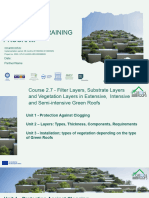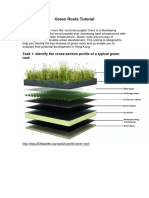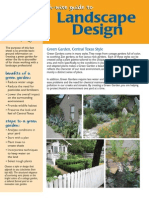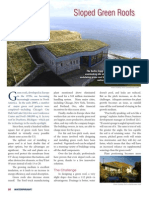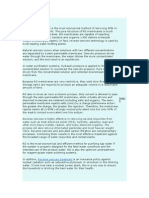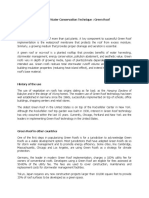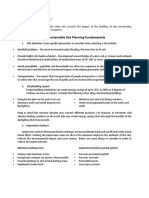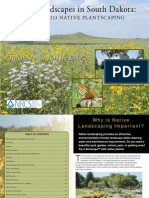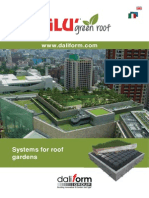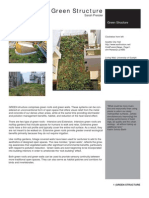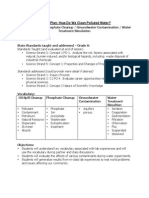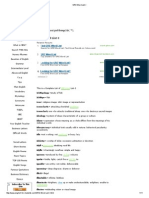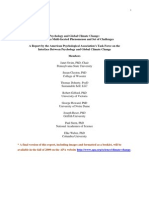Xeriscape: Considerations Commercial Status Implementation Issues Guidelines
Xeriscape: Considerations Commercial Status Implementation Issues Guidelines
Uploaded by
Tarun MattaparthyCopyright:
Available Formats
Xeriscape: Considerations Commercial Status Implementation Issues Guidelines
Xeriscape: Considerations Commercial Status Implementation Issues Guidelines
Uploaded by
Tarun MattaparthyOriginal Description:
Original Title
Copyright
Available Formats
Share this document
Did you find this document useful?
Is this content inappropriate?
Copyright:
Available Formats
Xeriscape: Considerations Commercial Status Implementation Issues Guidelines
Xeriscape: Considerations Commercial Status Implementation Issues Guidelines
Uploaded by
Tarun MattaparthyCopyright:
Available Formats
Xeriscape
DEFINITION CONSIDERATIONS COMMERCIAL STATUS IMPLEMENTATION ISSUES GUIDELINES
1. 2. 3. 4. 5. 6. 7. Planning and Design Soil Improvement Appropriate Plant Selection Practical Turf Areas Efficient Irrigation Use of Mulches Appropriate Maintenance
CSI NUMBERS:
02800 02810 02820 02830 20833 02836 02750 landscape soil preparation seeding trees. shrubs,groundcover plants mulch irrigation system
DEFINITION:
Xeriscape landscapes are defined as quality landscaping that conserves water and protects the environment. There are seven principles associated with Xeriscape landscapes: 1. 2. 3. 4. 5. 6. 7. Planning and Design Soil Improvement Appropriate Plant Selection Practical Turf Areas Efficient Irrigation Use of Mulches Appropriate Maintenance
CONSIDERATIONS:
Xeriscape expertise and materials are readily available in Austin. Thirty eight percent of the water consumed in Austin is attributable to outside watering. From a water conserving perspective, Xeriscape landscapes are very valuable. Additionally, Xeriscape landscapes can be designed to aid in energy
conservation and reduce the need for chemical and fertilizer use. Efficient irrigation is perhaps one of the easiest principles to achieve, but has much to do with the water users habits and system design.
Commercial Status
T E C H N O L O G Y S U P P L I E R S
Implementation Issues
F I N A N C I N G A C C E P T A N C E R E G U L A T O R Y
C O S T
Buffalo Grass
Xeriscape
Satisfactory
Satisfactory in most conditions
Satisfactory in Limited Conditions
Unsatisfactory or Difficult
COMMERCIAL STATUS
Technology: Xeriscape-related expertise is readily available. Extensive research and marketing has been conducted to promote Xeriscape. Automatic irrigation technology is well-developed. SUPPLIERS: Plentiful except for buffalograss for turf areas. There are limited producers of buffalograss.
COST: Xeriscape landscapes can initially cost more than conventional landscapes due to the comprehensive nature of Xeriscape design and replacement of inexpensive turf with other plants. A Xeriscape landscape can be phased in by the owners of a new home after the builder has initiated some early stages, and thereby minimize the cost impact. Buffalograss may cost more than other turf grasses but the cost is becoming more competitive. Xeriscape will decrease the life cycle maintenance costs of landscaping. There is ample competition to insure competitive pricing of items such as water conserving irrigation systems. However, the best irrigation systems are initially the most costly.
IMPLEMENTATION ISSUES
FINANCING: Available. PUBLIC ACCEPTANCE: Xeriscape is misconceived by some to be unattractive, or predominantly cactus or rock landscaping. The decreased turf area in some Xeriscape designs is not preferred by some and is associated as the predominant characteristic of these landscapes. However, there are appropriate turf grasses that can be used in Xeriscape type landscapes that ascribe to the basic Xeriscape principles. REGULATORY: There are no regulatory barriers to the use of Xeriscape landscapes. Xeriscapes are favored by local authorities and currently rebates are available for residential applications from the ECSD Water Conservation Program.
GUIDELINES 1.0 Planning and Design
This is the first and most important step in Xeriscape landscaping. The Xeriscape landscape takes into account the regional and microclimatic conditions of the site, existing vegetation and topographical conditions, the intended use and desires of the owner, and the zoning of plant materials according to their water needs. The landscape plan should allow the landscaping to be phased in, with initial phase installation and a future phasing plan as part of the building package. Such a feature can be important in speculative home construction, and gives added value. 1.1 Proper site planning Design of floorplans and foundations should reflect the site topography.Split level plans, terracing, and decks can help integrate built features into site conditions and minimize the cost and effects of grading. Building orientation on an east-west axis with glass area minimized on walls with maximum solar exposure will decrease energy demands for cooling, particularly when combined with proper placement of shade producing plants.
1.2 Preserve and protect as much existing vegetation as possible. Incorporate existing trees when locating structures and powerlines, allowing room for them to grow if they are not at mature size. (The citys Land Development Code tree preservation regulations controls commercial and multi-family construction projects. Under these rules, trees with a trunk caliper of 8 inches or more must be included in a tree survey, and trees with a 19-inch caliper or more are considered protected.)Protect trees from damage during construction with clearly visible fencing located below the outermost branches (see Figures 1 & 2) and flags in overhanging branches. See illustrations for where to locate fences. (According to surveys conducted by Builder Magazine, trees can increase the value of a home by up to 15%.) Wooden slats attached to tree trunks will not provide adequate protection. Much of the damage that occurs to trees during the construction process is due to soil compaction from heavy equipment and materials being driven or stored under trees. Roots which extend out far beyond the trunk are damaged when soil becomes compacted. This will cause trees to go into a gradual decline, and eventually die.
Filling or cutting in tree root areas will also kill trees. Use tree wells or decks to work around tree trunks, roots and slopes.
Avoid trenching in tree root zones; try tunneling instead to locate buried utility lines. If areas around trees must be paved, use pervious materials (see section on Pervious Paving ) or, at a minimum, leave large holes spaced at regular intervals in the trees root zone (openings will help give trees needed air and water). Never dump paints or solvents near trees. These cause plant death and soil contamination. Dispose of all waste materials properly.
1.3 Preserve and protect topsoil on construction sites. Topsoil is a valuable resource which can only be replaced with expensive hauling from other sites, or with many years of the natural process of soil formation. In areas where topsoil must be stripped:Collect and stockpile the topsoil for future use on the site. Place erosion control devices such as haybales or erosion control fencing in all areas where construction disturbs the soil. (Such devices will help prevent the loss of topsoil during rainfall, when soil can be washed downstream causing site losses and non-point-source pollution. 1.4 Stabilize or cover all bare soil areas by the time construction is completed. Extreme slopes, hillsides, and stream banks can be stabilized with vegetation, terracing, dry stack limestone, rubble, or rip-rap.In landscaped areas, a thick layer of organic mulch should be applied to planting beds. Planted slopes can be covered with erosion control fabrics or jute netting before groundcover or other plantings are added. This will help hold soil in place during the plant establishment period. Shredded mulch which tends to form a mat should be used in sloping areas, as it tends to wash out less than other types. 1.5 Landscaping for energy conservation should be an integral part of any landscape design. Plant deciduous trees on the west and southwest sides of structures. Such trees can create enough shade to lower roof and wall temperatures by up to 20 degrees.Deciduous trees that lose their leaves in winter will create summer shade and allow sunlight through open branches to warm and light the home during winter. (Note that with leaves off, there can be significant shading from the branches.) Shade can also be created by using a combination of landscape features, such as shrubs and vines on arbors or trellises.) Shade the outdoor compressor unit of an air conditioning system. This can help save up to 10% on summer cooling bills. Be sure to leave room (at least 3 feet) for air flow and service access. Natural cooling without air conditioning can be enhanced by locating trees to channel southeasterly summer breezes. Cooling breezes will be able to pass through the trunks of trees placed for shading. See also the Sourcebook chapter on Landscaping for Energy Conservation
1.5.1 Create living windbreaks to block cold winter winds.
Plant evergreen shrubs and/or trees on the north and northwest sides of a building. Varieties that branch all the way to the ground are most effective. Several staggered rows of plantings should be located on the leeward side of the wind. For best wind protection, plant windbreak trees a distance from the house equal to 5 to 7 times the height the trees will be when mature. (For example, if planting a windbreak whose mature height will be 25 feet, locate it 125 to 175 feet (5 to 7 times 25 feet) from the building.) See the Energy section of the Sourcebook for more information on landscaping and site planning for energy saving.
2.0 Soil Improvement
2.1 Have soil analyzed to help determine suitable plants and the need for any soil amendments. 2.2 Add organic matter to planting soil to enhance plant health. This improves soil texture and moisture retention. (Soil rich in organic matter provides nutrients and micro-organisms beneficial to plants.)For planting beds, spread 2 inches of organic matter and mix it in 6 inches deep. For soil to fill a hole for planting shrubs or trees, mix 1/3 organic matter into the soil. (Some native plants may not require this, as they are well adapted to poor soils. Check with your supplier.) Compost and composted sludge products such as Dillo Dirt are excellent sources of nutrients for ornamental landscapes. Such products release nutrients slowly to the plants, making frequent fertilizing unnecessary and minimizing the risk of fertilizer washing out of sites and becoming non-point source pollution. Dillo Dirt is a recycled material produced by the City of Austin at Hornsby Bend Sludge Treatment Plant. 2.3 Add other amendments as necessary. Soils in the Austin area tend to be naturally rich in potassium.A soil test is an important first step in determining whether fertilizer is needed, and if so, what type. (The addition of fertilizers containing potassium, for example, may be unnecessary or even harmful.) To reduce the need for fertilizer on established turf, use the Dont Bag It program: le ave clippings in place to decompose after mowing. This recycles important nutrients back into the soil. The addition of gypsum and sand can improve the workability and drainage capacity of soil. Soils in the Austin area with large amounts of clay and stones are difficult to work with. If little soil is available and bedrock is in evidence on the site, planting holes are sometimes dug in solid rock. If this occurs, be sure all planting holes drain thoroughly before planting. Standing water on plant roots can be lethal. 2.4 Choose topsoil wisely. If topsoil is imported from off-site, be sure it is of high quality. (There are many grades of topsoil, and the end use will determine what type of topsoil to use. For example, the best material for grading and filling may not be good for planting.)The natural clay type soils in our area are suitable for many native plantings. (Native plants are naturally adapted to such soils, and may not thrive on soil blends which dont mimic the natural conditions.) Weeds and other pests such as fire ants can easily be imported onto a site via topsoil. Be sure to use reputable suppliers of soils who can verify their soil source.
3.0 Appropriate Plant Selection
3.1 Select plants that require a minimal amount of supplemental watering. Most Xeriscape plants will need no supplemental watering after an establishment period, unless there is an extreme drought. The establishment period after installation may require from 18 to 24 months.Almost any plant can be used in a Xeriscape landscape if grouped according to its water needs.
Annual and exotic plantings can be located in small, easily accessible areas to make maintenance easier. Irrigation can then be zoned according to plant water needs to make efficient irrigation possible. Many native plants are well adapted to the natural soil and rainfall conditions of our area. They have protection mechanisms that cause them to go dormant during periods of stress. They may appear brown, but will turn green again when temperatures improve and it rains. 3.2 Choose a diversity of plant species. Avoid planting large numbers of only one plant species, which can create a monoculture susceptible to pest or insect problems. (A variety of plant species occurs in nature, making more stable and diverse plant populations.)The abundance of Xeriscape plants trees, shrubs, perennials, groundcovers, vines and grasses available in the nursery industry make it possible to choose plantings which give color and interest (flowers, fruits, berries, and foliage) year-round. 3.3 Buy from reputable suppliers and nurseries. Well-established plant suppliers know the exact sources of their plant materials. Information on where plants are nursery-grown or field-dug should be available.For field collected specimens, environmentally sound collection techniques should be used and permission of the land owner obtained. Rare plants should never be collected from the wild. Field-dug specimens should be heeled in. (This means allowing plants to acclimate for a period of time before selling and replanting.) 3.4 Use Texas-Grown plants if possible. This cuts down transportation costs and increases the viability of plant materials.The Texas Department of Agriculture has a consumer awareness program which labels plants Texas Grown with a special tag. Look for these tags and ask for Texas Grown plants when ordering plants. A list of plants suitable to our climatic region can be obtained from the City of Austin Water Conservation Program in the Environmental and Conservation Services Department or the Agricultural Extension Service. See Resource section.
4.0 Practical Turf Areas
Practical turf areas mean turf areas whose size is suited to the intended use. Huge lawns of exotic grasses will require more maintenance and care than any other type of landscape plant. Lawns may be needed as childrens play areas, for pets, sports, or simply for the aesthetic appeal of turf which some people prefer. The maintenance needs of turf can be minimized by the shape of the area, the irrigation equipment used, and the turf type selected. 4.1 Design turf areas in rounded, compact shapes to water and mow more efficiently. Curving borders of plant beds around turf areas and the use of mowing strips can make mowing and edging easier.Avoid long narrow areas of turf, which are difficult to water efficiently. Locate turf areas close to the house, and lower-maintenance areas near the edges or rear of the lot. 4.2 Design turf areas so they can be watered separately from other landscape plants.
If using an automatic irrigation system, the grass areas can be zoned to be watered according to the needs of the grass type.For non-automatic systems, use hose-end efficient sprinklers for grass areas and soaker hoses for beds. Watering times will vary by plant type. 4.3 Choose turf appropriate for the location. The following turf types are listed from the most to the least drought tolerant: Buffalo grass is a native prairie grass which reaches a maximum height of 6 inches and can be left unmown. Buffalo grass generally requires full sun, but some of the newer varieties such as Prairie and 609 Buffalograss have improved shade tolerance (as little as 4 hours of sun per day). These varieties are available as sod, and exhibit a darker green color. Bermuda grass is the most commonly used drought-tolerant grass in Texas. It is available as seed or sod and requires full sun. Tifway and Texturf 10 varieties have improved qualities. Zoysia grass is a slow-growing grass for full sun to partial shade. It is available as sod. Belair or Myer Z52 are good varieties for residential use. Zoysia may have special mowing needs, such as a reel-type mower. St. Augustine grass is best for use in shady spots. It has poor drought and freeze tolerance. It is available only as sod, and if grown in full sun has the highest water needs of the grasses listed here. 4.4 Avoid planting grass on slopes. Sloping areas are difficult to mow (making Buffalo grass the only appropriate choice) and difficult to water without runoff.Terracing of slopes can help slow down water. Plant groundcover, shrubs, and perennials to minimize the difficult maintenance problems of slopes. Many slopes can be left in their natural state. 4.5 Minimize grass areas by using alternatives. There are many alternatives to grass plantings which are aesthetically pleasing and low-maintenance. Planting beds are a logical alternative to grass if the cool green appearance of plants is still desired. Wildflowers can be incorporated into native groundcovers and grasses. Mulch beds of bark, stone or gravel can be used as pathways, or around driveways and utility areas.
Childrens play areas can be covered with sand or bark mulch to create inexpensive safety zones. Paving products made of recycled tires are available to create a ground surface that minimizes injuries. Decks and patios add value to homes and increase the square footage of living space. (Use pervious paving materials if possible. Decks can be built around existing trees, over slopes, and allow rain infiltration.)
5.0 Efficient Irrigation
5.1 Use an efficient irrigation system designed by a licensed irrigator. The type of watering equipment best suited to the job depends on the landscape, design, layout and budget. The irrigation design should be integrated with the design of the landscape. A simple garden hose and sprinkler with a few soaker hoses thrown in may be the best way to water some landscapes. Drip or underground systems may be more appropriate for other landscapes or clients.It is important to note that a newly installed landscape will require more water during an establishment period of one to two years. After this time, a Xeriscape landscape may require no irrigation unless it is a drought period. Unless there are large expanses of non-native turf and other thirsty plants, some quick-couplers (temporary hose connection) in conjunction with drip irrigation may be sufficient. However, many homeowners prefer the convenience an automatic irrigation system provides. 5.2 Install a water efficient automatic irrigation system, this includes: A timer that allows for scheduling every 5-7 days (14 or 15-day programming) and independent zone programming capability.Features such as multi-cycling (or multiple start times) will help in watering areas which may need several short irrigation cycles to avoid runoff. An inexpensive rain shut-off device, which will prevent unnecessary irrigation during rain. A soil moisture sensor. Unlike the rain shut-off device, the soil moisture sensor actually measures soil moisture, and overrides programmed irrigation when the soil moisture level is adequate. Non-mist type low trajectory nozzles and pressure-compensating devices for spray systems in turf areas. or micro-spray heads should be used for spray systems in turf areas. A zoned approach whereby plants of similar water requirements are grouped together in the same zone capable of independent station programming (i.e. turf areas separate from shrub areas, sunny areas separate from shady areas). 5.3 Use low-flow irrigation equipment. Evaporation losses can be minimized by drip irrigation, soaker hoses, or bubblers. Drip irrigation systems are ideal for watering plants in beds and gardens. Drip lines require no expensive underground trenching, and are easy to utilize in a retrofit of an existing landscape. Drip irrigation uses a flexible hose system which can be easily modified, to apply water at the ground surface to individual plants. Emitters are punched into the supply line where they are needed. A variety of types and flow rates for emitters are available. If water pressure at the source exceeds 30 psi, a pressure regulator may be necessary. Filters to remove sediment should be installed at the water source. Flush caps should be installed at the
ends of the drip supply lines so that the entire system can occasionally be flushed of contaminants. Drip lines should be secured to the soil surface and covered with organic mulch to improve appearance and protect them from sunlight.
5.4 Maintain the system. Irrigation systems need regular maintenance to ensure proper working order and to adjust irrigation scheduling. A complete system audit should be conducted annually, and irrigation schedules adjusted quarterly at a minimum. (A training program for Irrigation Auditors is now offered by the Texas Agricultural Extension Service.) Irrigation lines should be flushed and all stations, heads, nozzles, and/or emitters checked for proper functioning. 5.5 Dont forget client interaction. Provide the owner with a plan of how the system is built, and instructions for use of the system.Post the current irrigation schedule inside the controller box. (Be sure to note that seasonal adjustments to the irrigation schedule will be necessary.) Give the owner an orientation session on how to operate the system. Many irrigation systems which are efficiently designed are never used efficiently because the owner is unaware of the importance of his/her role in scheduling and maintenance after the system is installed. Offer a maintenance and seasonal system adjustment visit as a part of your follow-up package. 5.6 Water only when plants need it and water deeply. Deep, more drought tolerant root systems will develop from a weekly deep soaking. Irrigate in the coolest part of the day (early mornings and evenings) to avoid evaporation loss and wind drift. Nighttime watering can encourage disease. Irrigation equipment should be tested to determine how long it takes to apply one inch of water. Wet the soil to a depth of five or six inches, and allow it to dry out between waterings. (The homeowner can learn to recognize the signals of a thirsty landscape. Shrubs will begin to droop and grass will lie flat and leave footprints when walked on.) As a general rule, during the growing season most grass needs about one inch of water per week. This will vary depending on soil type and depth, sun, plant conditions, and rainfall occurrence. Watering can taper off gradually as fall arrives and gradually increase in spring. Plants dont need as much water in winter, but will still benefit from monthly irrigation if there is no rainfall.
6.0 Use of Mulches
6.1 Use a deep layer of mulch in planting beds to help retain moisture, slow weed growth, and prevent erosion. The use of mulches on sloped areas along with terracing and plantings can help prevent runoff and erosion problems. Examples of organic mulch material include: shredded bark wood chips pine needles straw pecan hulls cotton seed hull composted leaves shredded cedar.
The depth of mulch needed will depend on the type used. As a general rule, the coarser the material, the deeper it should be applied. A 3 to 4 inch layer of bark mulch should be sufficient. Mulch needs to be reapplied as it decomposes. 6.2 Use inorganic mulches such as pea gravel, crushed granite or pebbles in unplanted areas. Such areas can become inexpensive pathways, utility areas, or decorative border strips. Dont use stone mulches in areas immediately adjacent to buildings, as they can heat up and cause glare. Medium colored stone, such as beige or light grey, is preferred over white, which causes glare, or black, which absorbs heat. 6.3 Use mulches from locally or regionally derived materials. This decreases transportation costs, and utilizes local resources. Organic mulches can be the byproduct of local Christmas tree recycling, tree trimming, land clearing, or sawmills. Stone mulches can be produced from regional quarries. Check with the supplier to determine the source of organic and inorganic mulches.
7.0 Appropriate Maintenance
The maintenance requirements of a Xeriscape landscape are generally less than those of a conventional landscape. This is due to a reduction in turf area and unadapted plants that might have more disease, insect control, watering and fertilizer demands. However, there is no such thing as a maintenance-free constructed landscape. In general, a properly maintained yard is hardier and better able to withstand drought, freezing and pest problems. Obviously, landscape maintenance is up to the owner. However, there are things a builder can do to make maintenance easier. 7.1 Provide a composting area and encourage its use.
Yard waste can be recycled into high-quality compost. This minimizes the load on landfills and encourages wise resource use. Choose a well-drained corner of the yard that is convenient to the kitchen and out of sight. Clear the area to expose the soil. Compost bins are easy to build. Remember: 1. Use inexpensive materials. 2. Allow for air circulation and 3. Make the bin wide enough to turn and lift compost. You can use chicken wire, woven wire, or inexpensive fencing to build a bin. Try using wood stakes, wire, or chain snaps to support and fasten the bin. Discarded wood pallets can be put together with wire to make an inexpensive rectangular bin. A portable bin can be built of wood slats and wire mesh. Cinder blocks or brick can be used if gaps are left to allow air circulation. Commercially prefabricated composters are available. See the Solid Waste section of the Sourcebook for more information on composting . 7.2 Mow correctly. Mow the grass when it is about 1/3 higher than the desired height. Clippings can be left where they fall, recycling nutrients into the soil. If clippings are collected, compost them with raked leaves and organic kitchen waste. Never mow lawns too short. (Proper mowing heights can help lawns use less water. Grass cut too short is stressed and dries out quickly.) Recommended Mowing Heights: Bermuda 1 1/2 to 2 1/2 inches St. Augustine 2 to 3 inches Buffalo Grass 3 to 4 inches Zoysia 2 inches
7.3 Fertilize wisely. Many native plants do not need fertilizer since they are adapted to natural soil conditions.Other plants, such as non-native grasses, need additional nutrients for healthy growth. Use recycled lawn clippings, compost, Dillo Dirt, or slow-release encapsulated nitrogen on lawns. 7.4 Use least-toxic methods of insect and disease control. Such techniques, otherwise known as Integrated Pest Management (IPM), take advantage of natural methods of control. This protects soil from contamination, inhabitants wildlife from harm, and waterways from being polluted with non-point source pollution.Old-fashioned methods such as installing a birdhouse for Purple Martins can help encourage natural insect control.
Chemical controls will destroy beneficial insects as well as harmful ones. Organic pest control such as insecticidal soaps and manual methods such as pulling weeds or using sand barriers may do the job. Beneficial insects such as ladybugs and beetles should be encouraged and can even be introduced into a landscape. Overwatering and nighttime watering may actually cause some diseases such as brown patch on St. Augustine lawns. Difficult problems such as fire ants can be tackled with boiling water treatments and growth regulators containing fenoxycarb.
You might also like
- Coral Island Reference GuideDocument15 pagesCoral Island Reference GuidegrimmekateNo ratings yet
- Architectural Thesis ManualDocument49 pagesArchitectural Thesis ManualTroy Jim89% (18)
- M2 - Design and Project Specifications of GR - Topic7Document21 pagesM2 - Design and Project Specifications of GR - Topic7Katarina KušarNo ratings yet
- Green Infrastructure (1)Document19 pagesGreen Infrastructure (1)cholan hariharanNo ratings yet
- Windbreak and ShelterbeltsDocument10 pagesWindbreak and ShelterbeltsAshok KumarNo ratings yet
- Vertical Gardens - An Innovative Element of Green Building TechnologyDocument10 pagesVertical Gardens - An Innovative Element of Green Building TechnologyPiyush SharmaNo ratings yet
- Terrace Garden Report..Document20 pagesTerrace Garden Report..prajwal raj75% (4)
- GreenroofsupplementDocument5 pagesGreenroofsupplementHugo OrNo ratings yet
- GB AssignmentDocument12 pagesGB AssignmentAvinash GudipatiNo ratings yet
- Stormwater Trees: Technical MemorandumDocument21 pagesStormwater Trees: Technical MemorandumRuthOlavereNo ratings yet
- Designer 8 - Classwork - Building TechnologyDocument15 pagesDesigner 8 - Classwork - Building Technologykate pinedaNo ratings yet
- Texas Earth Wise Guide To Landscape DesignDocument8 pagesTexas Earth Wise Guide To Landscape DesignFree Rain Garden Manuals and More100% (1)
- Landscaping GuideDocument8 pagesLandscaping Guidekokosmart007No ratings yet
- Green Roof Irrigation Guide 0Document15 pagesGreen Roof Irrigation Guide 0pejzazNo ratings yet
- Landscape GuidelinesDocument15 pagesLandscape GuidelinesPaunita BoancaNo ratings yet
- Proposal For The Installation of A Roof PDFDocument11 pagesProposal For The Installation of A Roof PDFTayi Wale ChiiNo ratings yet
- Design: LandscapeDocument16 pagesDesign: LandscapeAnuradhaKannanNo ratings yet
- Sloped Green RoofsDocument5 pagesSloped Green RoofsLiveRoof Green Roofs and LiveWall Vertical GardensNo ratings yet
- Green Roofs ProjectDocument13 pagesGreen Roofs ProjectvojinkoNo ratings yet
- Mulch Options For Erosion Control On Construction SitesDocument5 pagesMulch Options For Erosion Control On Construction SitesStephanyNo ratings yet
- Ecological Consideration of Site AnalysisDocument20 pagesEcological Consideration of Site AnalysisAUST BNo ratings yet
- Ele Hort NanajDocument4 pagesEle Hort NanajNarayanNo ratings yet
- Green ProjectDocument12 pagesGreen Projectamanjot_nitjNo ratings yet
- Specific Water Conservation TechniqueDocument6 pagesSpecific Water Conservation TechniqueGia PerezNo ratings yet
- Sustainable Site Planning FundamentalsDocument3 pagesSustainable Site Planning Fundamentalscarlo melgarNo ratings yet
- Green Roof System SolutionsDocument38 pagesGreen Roof System Solutionsmutton moonswamiNo ratings yet
- Principles of XeriscapingDocument3 pagesPrinciples of XeriscapingprashanthNo ratings yet
- Benefits of Planting and Protecting Trees Lec-7Document24 pagesBenefits of Planting and Protecting Trees Lec-7tsion tehoneNo ratings yet
- Presentation (2) ROOFTOP Assignment No 04Document4 pagesPresentation (2) ROOFTOP Assignment No 04Ravindu LakshanNo ratings yet
- Green Belt Pro 68Document12 pagesGreen Belt Pro 68i5ekc5q3fwNo ratings yet
- MD SWM Volume 2Document302 pagesMD SWM Volume 2julioalarcon13No ratings yet
- AssignmentDocument11 pagesAssignmentAzhar HaqueNo ratings yet
- South Dakota Living Landscapes: A Guide To Native PlantScapingDocument45 pagesSouth Dakota Living Landscapes: A Guide To Native PlantScapingFree Rain Garden Manuals100% (1)
- Green Roof: Prepared by Group 3 Punzalan, Eunice Salvador, Vergel San Miguel, DarrenDocument27 pagesGreen Roof: Prepared by Group 3 Punzalan, Eunice Salvador, Vergel San Miguel, DarrenRemiel Joseph Garniel BataoNo ratings yet
- Ground Covers For Arizona Landscapes: Cooperative ExtensionDocument14 pagesGround Covers For Arizona Landscapes: Cooperative ExtensionJessieNo ratings yet
- Design and Layout of A Small Commercial Greenhouse OperationDocument4 pagesDesign and Layout of A Small Commercial Greenhouse OperationjsenciachoqqueNo ratings yet
- Interior Design Landscaping: Ar. Kavya.JDocument26 pagesInterior Design Landscaping: Ar. Kavya.JGazal SOANo ratings yet
- Trees and Turf - 0321Document2 pagesTrees and Turf - 0321Ariel SplenserNo ratings yet
- Written Report IN Architecture Planning 1: Technological University of The Philippines-ManilaDocument9 pagesWritten Report IN Architecture Planning 1: Technological University of The Philippines-ManilaAmy PinedaNo ratings yet
- Domurath 2009Document6 pagesDomurath 2009Marcus Vinicius Sant'AnnaNo ratings yet
- Terrace GardenDocument15 pagesTerrace GardenKhyati Vasani100% (2)
- Green Roofs ReportDocument45 pagesGreen Roofs ReportUrvi VarmaNo ratings yet
- Vidya Pratishthan's School of Architecture BY Shweta Jayant PuriDocument8 pagesVidya Pratishthan's School of Architecture BY Shweta Jayant PuriShweta PuriNo ratings yet
- Iglu'® Green Roof - Systems For Roof GardensDocument12 pagesIglu'® Green Roof - Systems For Roof GardensDaliform GroupNo ratings yet
- Green Roof 2Document20 pagesGreen Roof 2Dalibor CetojevicNo ratings yet
- Green Structure: Sarah PreislerDocument5 pagesGreen Structure: Sarah PreislerVictor ValentiusNo ratings yet
- Hard N Soft LandscapeDocument5 pagesHard N Soft Landscapeprazol11223350% (2)
- Gi EconDocument12 pagesGi EconBanibrataChoudhuryNo ratings yet
- A Greenbelt Is A Strategy and Property Use Area SeDocument5 pagesA Greenbelt Is A Strategy and Property Use Area SeY SrikanthNo ratings yet
- Alley CroppingDocument19 pagesAlley CroppingbalsalchatNo ratings yet
- Tress and TurfDocument2 pagesTress and Turflahsivlahsiv684No ratings yet
- Landscape Water Conservation-Principles of Xeriscape PDFDocument4 pagesLandscape Water Conservation-Principles of Xeriscape PDFsinnombrepuesNo ratings yet
- Informasi Sistem Roof GardenDocument8 pagesInformasi Sistem Roof GardenMoch Rifki FahlefiNo ratings yet
- Unit 2Document12 pagesUnit 2gk mNo ratings yet
- Green RoofDocument18 pagesGreen RoofMinh Tu NguyenNo ratings yet
- Green Roof Specifications and StandardsDocument12 pagesGreen Roof Specifications and StandardsCastoroil7No ratings yet
- Sustainable Site Planning and Landscape DesignDocument2 pagesSustainable Site Planning and Landscape Designsusmita sethi100% (1)
- The Sustainable Landscaper: A Guide to Eco-Friendly Practices for HomeownersFrom EverandThe Sustainable Landscaper: A Guide to Eco-Friendly Practices for HomeownersNo ratings yet
- Sustainable Landscape Characteristics: A Comprehensive Guide to Building Eco-Friendly Garden DesignFrom EverandSustainable Landscape Characteristics: A Comprehensive Guide to Building Eco-Friendly Garden DesignNo ratings yet
- Lesson Plan: How Do We Clean Polluted Water?Document15 pagesLesson Plan: How Do We Clean Polluted Water?Tarun MattaparthyNo ratings yet
- Gre Word List-M: Window - Parent.Postmessage ('Die', ' ')Document5 pagesGre Word List-M: Window - Parent.Postmessage ('Die', ' ')Tarun MattaparthyNo ratings yet
- Gre Word List-O: Window - Parent.Postmessage ('Die', ' ')Document3 pagesGre Word List-O: Window - Parent.Postmessage ('Die', ' ')Tarun MattaparthyNo ratings yet
- Gre Word List-L: Window - Parent.Postmessage ('Die', ' ')Document3 pagesGre Word List-L: Window - Parent.Postmessage ('Die', ' ')Tarun MattaparthyNo ratings yet
- Gre Word List-I: Window - Parent.Postmessage ('Die', ' ')Document11 pagesGre Word List-I: Window - Parent.Postmessage ('Die', ' ')Tarun MattaparthyNo ratings yet
- GRE Word List-F: Display DisplayDocument4 pagesGRE Word List-F: Display DisplayTarun MattaparthyNo ratings yet
- Gre Word List-H: Window - Parent.Postmessage ('Die', ' ')Document4 pagesGre Word List-H: Window - Parent.Postmessage ('Die', ' ')Tarun MattaparthyNo ratings yet
- GRE Word List-GDocument4 pagesGRE Word List-GTarun MattaparthyNo ratings yet
- GRE Word List-C: Human BodyDocument8 pagesGRE Word List-C: Human BodyTarun MattaparthyNo ratings yet
- General Climatic Characteristics of Ohrid Region: Annual Air Temperature Anomalies at Main Met - Station OHRIDDocument4 pagesGeneral Climatic Characteristics of Ohrid Region: Annual Air Temperature Anomalies at Main Met - Station OHRIDTarun MattaparthyNo ratings yet
- Climate Change PDFDocument230 pagesClimate Change PDFTarun MattaparthyNo ratings yet
- Hydroponic Green Fodder MachineDocument5 pagesHydroponic Green Fodder MachinelegendmahenNo ratings yet
- Module 16. Plants and Animals On Earth and Their HabitatsDocument5 pagesModule 16. Plants and Animals On Earth and Their HabitatsReboy DamulogNo ratings yet
- Grass Block Installation GuidelinesDocument6 pagesGrass Block Installation GuidelinesComaNo ratings yet
- Grassland Biome Fact FileDocument3 pagesGrassland Biome Fact Filer MH100% (1)
- Literature Review On Panicum MaximumDocument5 pagesLiterature Review On Panicum Maximumea7sfn0f100% (1)
- Bamboo Crafts: DURAN, Graciella ESCOBAN, Maricel VICENCIO, AndrelaDocument20 pagesBamboo Crafts: DURAN, Graciella ESCOBAN, Maricel VICENCIO, AndrelaAllan Escoban Jr.No ratings yet
- Grass FamilyDocument55 pagesGrass FamilyMostafa A MansiNo ratings yet
- Update For WebsiteDocument4 pagesUpdate For Websiteapi-387766473No ratings yet
- SR Feed Jabalpur GoldDocument23 pagesSR Feed Jabalpur GoldKamalsingh MalviyaNo ratings yet
- Development of Kangkong BreadDocument14 pagesDevelopment of Kangkong BreadJohnMichaelAnol100% (1)
- Sample Capstone PDFDocument17 pagesSample Capstone PDFMark Julius FulgencioNo ratings yet
- B&BC Botanical Society Newsletter - Issue 2 (2015)Document26 pagesB&BC Botanical Society Newsletter - Issue 2 (2015)EcoRecordNo ratings yet
- Bamboo Resources Conservation and Utilization in MalaysiaDocument18 pagesBamboo Resources Conservation and Utilization in Malaysiauzaimy100% (1)
- Cereals: With The Homeodynamic MethodDocument27 pagesCereals: With The Homeodynamic MethodKonstantinos Zafeiriadis100% (1)
- ReedasabuildingmaterialDocument20 pagesReedasabuildingmaterialVania BagusNo ratings yet
- Common Hippopotamus Husbandry GuidelinesDocument105 pagesCommon Hippopotamus Husbandry Guidelinesgabrielwerneck0% (1)
- NABARD Master Notes 1Document31 pagesNABARD Master Notes 1bp chowdhuryNo ratings yet
- Housing and FencingDocument14 pagesHousing and FencingDave DimayugaNo ratings yet
- Rangeland Degradation and Management Approaches in Balochistan, PakistanDocument10 pagesRangeland Degradation and Management Approaches in Balochistan, PakistanomerNo ratings yet
- Morphology and Growth Development of Rice PlantDocument13 pagesMorphology and Growth Development of Rice Plantapi-249034018100% (1)
- Farmers Primer in Growing Upland RiceDocument291 pagesFarmers Primer in Growing Upland RiceAnonymous HXLczq3100% (1)
- NABARD Master Notes PI 2 Lyst1715221097394Document44 pagesNABARD Master Notes PI 2 Lyst1715221097394Paradayil KiranNo ratings yet
- AG Science ProjectDocument1 pageAG Science ProjectMrGilmartinNo ratings yet
- ĐỀ 15Document7 pagesĐỀ 15DistressNo ratings yet
- Bamboo PDFDocument14 pagesBamboo PDFArchita DuttaNo ratings yet
- Lemon Grass Ni TristanDocument2 pagesLemon Grass Ni TristanRalph Angelo CortezNo ratings yet
- Young Bamboo Culm FlourDocument6 pagesYoung Bamboo Culm FlourBoodjieh So ImbaNo ratings yet
- IJRR47Document8 pagesIJRR47htinhtinlinnaing6No ratings yet
- GERADocument14 pagesGERAJeff Angelo GalingNo ratings yet


